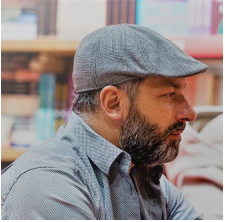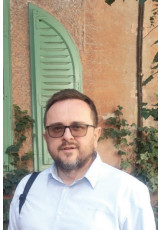tefan Rashkovski (Skopje, 1990) started his activity as a journalist immediatly after his bachelor studies. Then he worked in the field of Education, Labour and Social Policy; and, subsequentlym in Defence and Foreign Affairs – where he gained experience in international relations and communications. At that time he was finishing the first master degree in Political Science with focus on political marketing. In the same manner, while studying at Corvinus University of Budapest at the department of International Relations, he was engaged in an internship in the Embassy of Republic of Macedonia in Budapest as political analyst. Now he is finishing the second year of PhD studies and his academic activities are chiefly connected with research on the issue of political violence. We are publishing a part of the paper on which his intervention in the conference was based; this paper was prepared in collaboration with the young scholars Deniz Horuz (Szent Istvan University, Godollo, Hungary) and Katarína Sárvári (Corvinus University of Budapest, Hungary). The full version will be included in a book that will be published soon by LOJA Centre with the contributions for this conference.
Challenges are the steps on the stairway toward growth. This is a natural rule. It implies that one has to put effort and employ one’s full capacity to overcome an obstacle that leads toward unlocking inner potentials and developing a particular set of skills that in themselves represents the growth of the individual. This is how human beings can develop to their maximum potential, that is, only by facing and overcoming challenges. The environment itself is what generates the challenges for human beings whether it is the jungle or the office. This situation is an everyday reality in all the aspects of life, including the classroom. What distinguishes the latter from all other are the circumstances that it provides. Namely, the classroom can be seen as the most constructive and the safest environment for growth that inevitably has positive impacts first on the individual and, through the individual, it influences the whole society. That is so because students, from the elementary and up to the highest levels of education, are pushed to interact with other individuals, all of which are different: that, by definition, is a challenge in itself. In the very least, one is exposed to and faces a complete stranger in a unknown environment where the student needs not just to accept and adapt in order to survive, to put it in evolutionary terms, but also to engage, interact, cooperate in order to thrive. This fosters learning and growth and the process of globalization facilitates it even more. Namely, globalization, which in the words of Marshall McLuhan made the world a global village, created what we now know as multiculturalism. Consequently, the need for multicultural classrooms arise and, with it, the concept of multicultural education. The process of globalization added quality to education and value to student growth by creating even more challenging environment in the form of the multicultural curricula and classroom. That is so because the multicultural classroom encompasses greater diversity that naturally is followed by greater challenges and therefore a greater potential for learning and growth. This is the main benefit of multicultural education, the overcoming of the cultural, religious, racial, ethnical and political barriers represented as challenges that the students are facing and overcoming in the multicultural classroom. Students develop student’s resilience, which is defined as the ability to thrive in the face of challenges. This serves to increase the understanding between peoples of different cultures, which means an improvement of the level of social consciousness that leads to greater levels of social justice and equality that ultimately leads to inclusiveness in the society. Multicultural education serves to create resilient students, which results in greater social justice, equality and inclusiveness in the society that ultimately enhances the process of globalization with its end goal to create a peaceful world society.
Besides the knowledge about particular subjects as part of the multicultural curricula, which in itself is rich and consequently of great value, multicultural education provides students with the necessary experience of life from the perspective of learning about humanity as a whole. This is done by mixing students from different ethnic, racial, religious, cultural and political backgrounds into the same classroom. They are exposed to diversity and prompt to interact and cooperate among themselves, which is how the students develop resilience and learn to overcome their own personal and more often than not, limiting worldviews that are conditioned by their background. Inevitably, there is an increase in the level of social consciousness, which implies less prejudice and hostility, and more understanding and equality. In short, “multicultural education compares and contrasts all people across racial and ethnic lines in an open atmosphere that is uncritical and free from value judgments. It studies diversity across cultures, examines the strengths and contributions of each, and promotes cultural pluralism as the ideal posture for society.”[1] Ultimately, this is how multicultural education increases the levels of social justice, equality and inclusiveness in the society. This is its greatest strength and its main role in the society. It is not a coincidence that “multicultural education grew out of the Civil Rights movement, and that it is grounded in the Western democratic ideals of freedom, justice, and equality.” [2]
The concept of resilience can have several meanings but it can be viewed only from one perspective. It means both elasticity and resistance from the perspective of facing and overcoming challenges. By definition, “resilience is the process of, capacity for, or outcome of successful adaptation despite challenging or threatening circumstances.”[3] Other authors define resilience as “ability to recover rapidly from difficult situations” and “capacity to endure ongoing hardship in every conceivable way. Тhe action or act of rebounding or springing back; the quality or fact of being able to recover quickly or easily from, or resist being affected by, a misfortune, shock, illness or as a basic strength underpinning positive characteristics within a person’s emotional and psychological makeup”[4] The concept of resilience is also applicable to the sphere of education and especially when it comes to the multicultural classroom. By its very nature, that is, by mixing greater amount of diversities, the multicultural classroom inevitably poses greater challenges for the participating students, who will need to develop resilience in order to overcome them and thrive. This is how the concept of “resilience in education” came into being. According to Bamford, resilience in education means the „ability to thrive in the face of adversity”.[5] The importance of the concept of resilience in education can be seen best in connection with the multicultural classroom. It generates the greatest amount and intensity of challenges for the students, since besides just mingling students from different background, what the multicultural classroom does is expanding the previously culturally, ethnically, religiously and politically conditioned and limited worldviews of the students by breaking those barriers. The purpose is to create something greater on individual and collective level as well. This can be a painful and challenging process, which means that the students must be equipped with inner fortitude and properly guided by their teachers in order to develop resilience: it will serve as a tool for overcoming those barriers and thrive in the face of the challenge both personally and academically. Educational resilience is also defined as “the heightened likelihood of success in school and other life accomplishments despite environmental adversities brought about by early traits, conditions, and experiences.” [6]The teachers’ approach as well as the family and the community itself play important roles in this sense. Essentially, this is how the process of globalization influences the breaking of barriers and building of bridges in a top to bottom perspective. Multicultural education is the tool by which the process of globalization breaks down barriers and builds bridges amongst students of different background and students’ resilience is the instrument that the multicultural education uses to influence the society as a whole. Ultimately, the gap between different cultures, ethnicities, religious and political groups can be narrowed down and, consequently, people are enabled to work for building greater levels of social justice, equality and inclusiveness in the society. Students’ resilience fundamentally comes as a response to the natural tendency of human beings to stick to what they identify themselves with. It’s a natural characteristic that per se cannot be considered as something negative. This is also the challenge in the multicultural classroom. Separation or segregation noticed in the students’ behaviour essentially can be considered as the cradle of what we can define as tribalism and its supreme form nationalism, which brings up divisions between people that sometimes can take a problematic trajectory in the society. As long as there are divisions of this kind, humanity is bound to enter into conflict. Nowadays, it is less frequent than in the past, but still the enmity that can arise from difference is always present as long as there is difference without understanding. The process of globalization mitigated the animosity between different peoples largely and multicultural education might be one of its most powerful tools for increasing the levels of social consciousness. It can serve to build a global inclusive society.
[1] Foerster, Leona. „Moving from ethnic studies to multicultural education”. USA: Agathon Press, Inc. 1982, pp, 124.
[2] Gatimu, Wangeci. „Undermining critical consciousness unconsciously: Restoring hope in the multicultural education idea”. USA: Springer, 2008, pp, 48.
[3] Johnson, Bruce. „Teacher–student relationships which promote resilience at school: a micro-level analysis of students’ views”. UK: British Journal of Guidance & Counselling, 2008, 36:4, pp, 385-398.
[4] Ploner, Josef. „Promoting student resilient thinking in diverse higher education learning enviroments”. UK: Research Gate, 2011, pp, 3.
[5] Bamford, Jan. et all. 2005, pp, 140-158.
[6] Morrison, Gale & Megan Redding Allen. „Promoting Student Resilience in School Contexts, Theory
Into Practice”, USA: 2009, 46:2, pp, 162-169.







